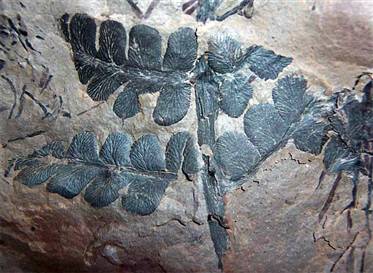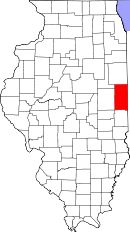Geologists discover world's largest fossil forest in the ceiling of an Illinois coal mine
By Eric Hand
ST. LOUIS POST-DISPATCH
04/24/2007
Illinois geologists have discovered the remains of one of the world's oldest tropical rainforests, preserved in the ceiling of a coal mine 250 feet below the surface.
The four-square-mile fossil forest — the largest find ever — is just south of Danville in Vermilion County, Ill., in the 300-million-year-old Herrin coal bed, a 6-foot-thick strip mined by a subsidiary of St. Louis-based Peabody Coal.
Plant fossils are common in coal beds. Coal, after all, is the compacted result of peaty plant material. But scientists are surprised by the size of this fossil bed, which they suspect came about because of a freak, fortuitous event: an earthquake that flooded and buried the forest. The vast extent of the fossil forest, which existed in a swampy time of giant dragonflies and tree ferns, has allowed the scientists to infer subtle ecological changes across the ancient landscape.
"This is almost as good as insects in amber," said Scott Elrick of the Illinois State Geological Survey and one of the authors of the study, which was published in the May issue of the journal Geology. Advertisement
Black Beauty Coal, the Peabody subsidiary, operates two mines in Vermilion County, where the Herrin coal bed is thickest. The Riola mine opened in 1996, and the Vermilion Grove mine was developed in 2001. In the past decade, as miners excavated room after room, they began to notice the imprints of leaves, logs and stumps in the ceiling. Some stumps were 5 feet in diameter, and one log was more than 100 feet long.
 |
| Pteridosperm, an extinct seed-producing fern-like plant. The underground forest covers 40 square miles. |
These are the remnants of extinct plants from a geological period 300 million years ago, called the Carboniferous, when the world was covered in a riot of green. Illinois was near the equator and much warmer and wetter.
It was also a time before flowering plants had evolved, and so the plants would seem bizarre to modern eyes, said study co-author Howard Falcon-Lang, a geologist at the University of Bristol in the United Kingdom.
|
The climate was ever wet, hot, and humid. The modern-day equivalent would be some of the peat swamps of Indonesia. |
"These are some of the earliest known rainforests to evolve on our planet," he said. "It was like something out of Jules Verne."
 Giant tree ferns would have formed a lower canopy 30 feet high. Poking up through the ferns would have been 100-foot-tall clubmosses — asparagus-like poles that sprouted crowns full of spores. It was the age of insects, with 6-foot-long millipedes and dragonflies with yard-long wingspans.
Giant tree ferns would have formed a lower canopy 30 feet high. Poking up through the ferns would have been 100-foot-tall clubmosses — asparagus-like poles that sprouted crowns full of spores. It was the age of insects, with 6-foot-long millipedes and dragonflies with yard-long wingspans.
"Imagine these forests alive with chirping and all these creepy crawlers," Falcon-Lang said.
An earthquake preserved all this for posterity. Elrick says it was akin to the 1811-12 earthquakes near New Madrid, Mo., which dropped a block of earth containing the Mississippi River, creating a natural dam that made Reelfoot Lake in Tennessee.
When the ancient earthquake hit, a sudden flooding in the submerged block killed the rainforest. Mud and silt rushed into the depression, preserving the stumps and logs in a layer that eventually became shale.
And that was the state of things until, 300 million years later, miners noticed shiny, funnel-shaped concretions that occasionally fell from the shale layer above them. They called them "kettlebottoms." But they were really fossilized stumps, whose roots fingered the peaty layer that ultimately became the coal seam the miners were working in.
"What's extraordinary about this discovery is that this forest has been preserved in its growth position," said Falcon-Lang. "It's an upright forest with trees still standing upright."
Lead study author Bill DiMichele, a paleobotanist at the Smithsonian Institution, said the lateral extent of the fossils allowed him to notice subtle changes in species diversity as he did surveys. As mining continues, the size of the exposed fossil forest grows by the day.
DiMichele is now doing inventories of ancient plants in two other actively mined Illinois coal seams, the Danville and the Springfield, which sit above and below the Herrin, respectively, and are separated by about a half-million years of geological time. Where most botanists do their work by walking through a forest, DiMichele takes elevators down mine shafts — to get beneath the forest.
"We get to walk under it and look up at it," he said. "It's the earthworm's view."
Powered by ShowMe-Net